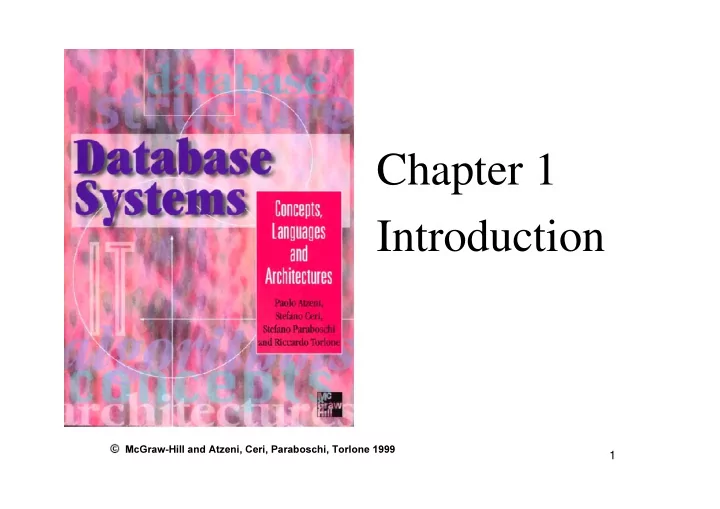

���������������������������������������������������� ������������������������ Chapter 1 Introduction 1 ������������������������������������������������������
���������������������������������������������������� ������������������������ ������������������ • Component of an organization that manages (gets, processes, stores, communicates) the information of interest – each organization has an information system, possibly not made explicit in its structure – usually, the information system operates in support to other components of teh organization • The very notion of information system is partly independent of its computerization; however, we are mainly interested in information systems that are, to a large extent, computerized 2 ������������������������������������������������������
���������������������������������������������������� ������������������������ ������������������������� • Information is handled and recorded according to various techniques: – informal ideas – natural language (written or spoken) – drawings, diagrams, – numbers – codes 3 ������������������������������������������������������
���������������������������������������������������� ������������������������ ���������������������� • As activities become systematized, appropriate forms of organization and codification for information have been devised • Look at information about people – in most countries a structure for the name has been introduced in the last few centuries – later, it was realized that it could be useful to keep track of birthdate and birthplace (and use them in order to identify people, together with the name) – more recently, social security numbers (or tax codes) have been introduced in order to obtain unique identification 4 ������������������������������������������������������
���������������������������������������������������� ������������������������ �������������������� • In most computer-based systems (as well as in many other places) information is represented by means of data – ���� raw facts, to be interpreted and correlated in order to provide ����������� • An example: – “John Smith” and 25755 are a name (or, better, a string) and a number: two pieces of data – if they are provided as a reply to a request: “Who is the dept head, and which is his/her extension,” then we get information out of them 5 ������������������������������������������������������
���������������������������������������������������� ������������������������ ��������� • This is the best that can be done to a large extent • In most cases data are a valuable resource, with a very long life- cycle: banking applications have had data with the same structure for centuries, well before computers were invented! 6 ������������������������������������������������������
���������������������������������������������������� ������������������������ �������� (generic definition) • ������������������������������������������������������ ��������������������������������� (more technical definition) • ��������������������������������������� 7 ������������������������������������������������������
���������������������������������������������������� ������������������������ ��������������������������������� • software system able to manage ������������������� that are – ������ (bigger, often much bigger, than the main memory available) – ������ (used by various applications and users) – ���������� (with a lifespan that is not limited to single executions of the programs that use them) and to ensure their reliability (so preserving the database in case of hardware or software failure) and privacy (controlling accesses and authorizations). Like any software product, a dbms must be ��������� (using the appropriate amount of resources, such as time and space) and ���������� (supporting the productivity of its users). 8 ������������������������������������������������������
���������������������������������������������������� ������������������������ ������� • Most organizations have a structure (departments, divisions, …) and each component is interested in a portion of the information system • The data of interest of the various components often overlap • A database is an ������������������� , shared by various components • Integration and sharing allow a reduction of ���������� and the consequent possibility of ������������� • Since sharing is never complete, DBMS provide support for privacy of data and access authorizations • Sharing also requires that multiple accesses to data are suitably organized: �������������������� techniques are used 9 ������������������������������������������������������
���������������������������������������������������� ������������������������ �������������������� • The management of large and persistent sets of data can be done by means of simpler tools: file systems • File systems provide also rough support for sharing • There is no sharp line between DBMSs and non-DBMSs: DBMSs provide many features, that extend those of file systems • The crucial issue is ������������� , take advantage of these features 10 ������������������������������������������������������
���������������������������������������������������� ������������������������ ������������������������ • In traditional programs that make use of files, each program includes a description of the organization of the file, which is often just a stream of bytes; there are chances of incoherence between the file and its description (or descriptions, if teh file is shared) • In DBMSs, there is a portion of the database (called the ����������� or ��������� ) that describes teh database itself, which is shared 11 ������������������������������������������������������
Recommend
More recommend